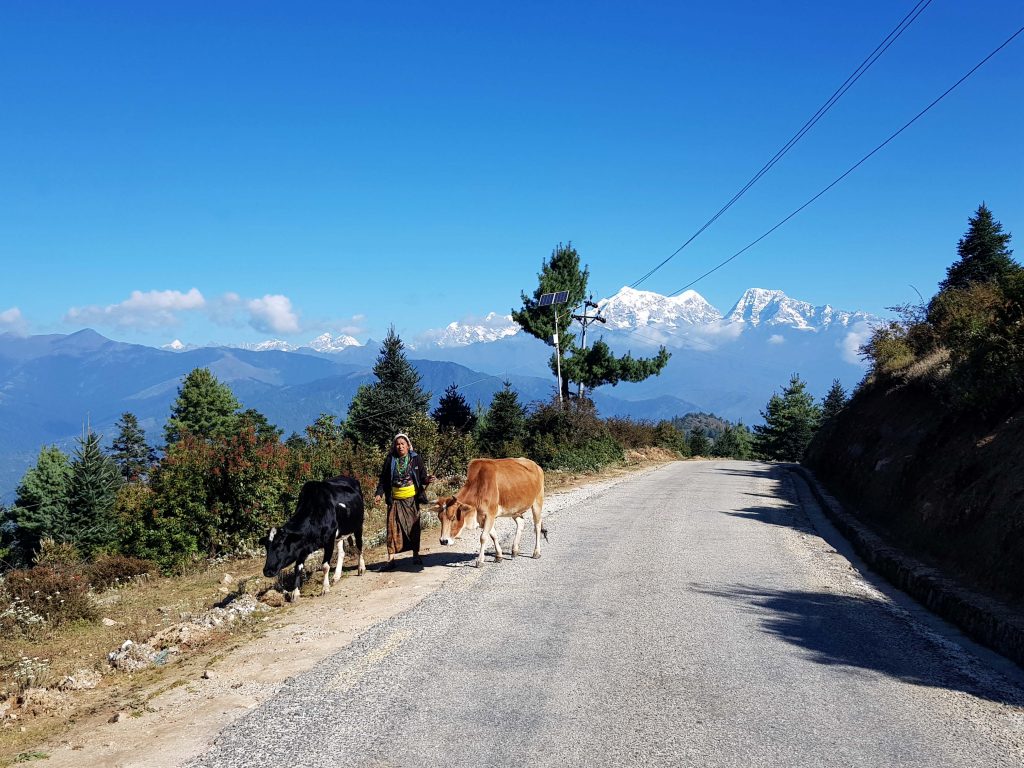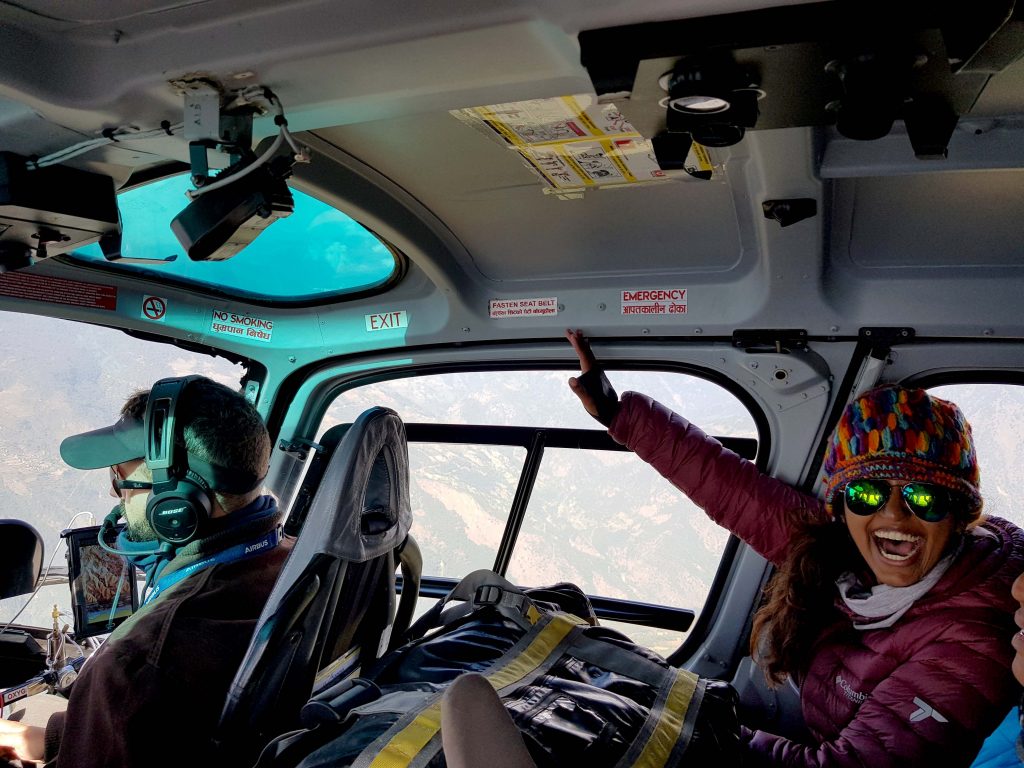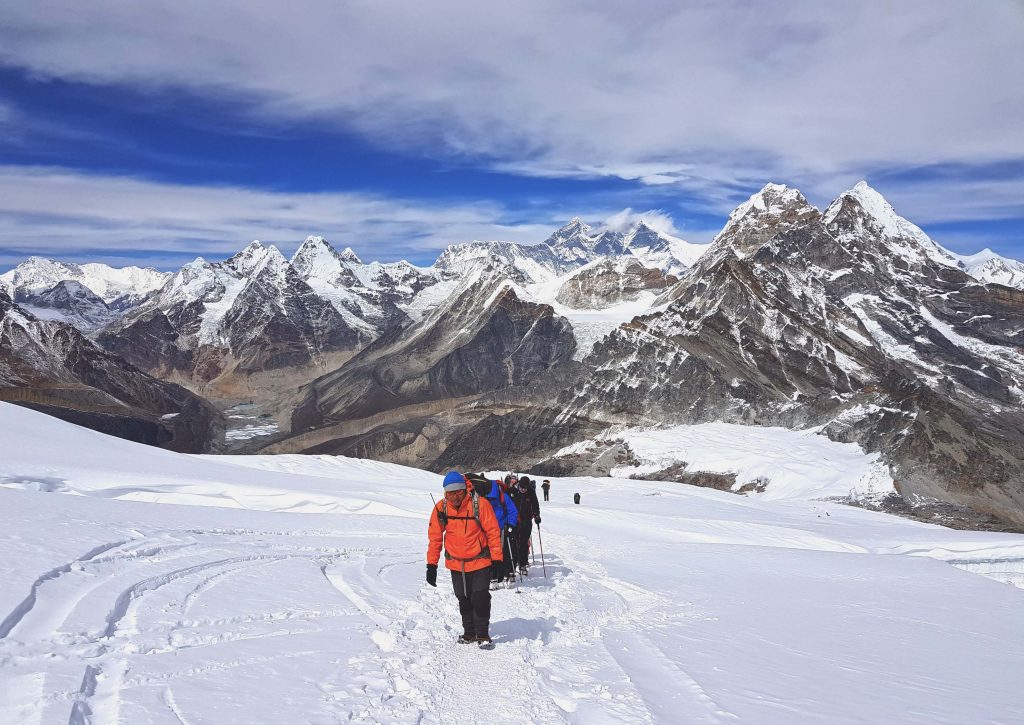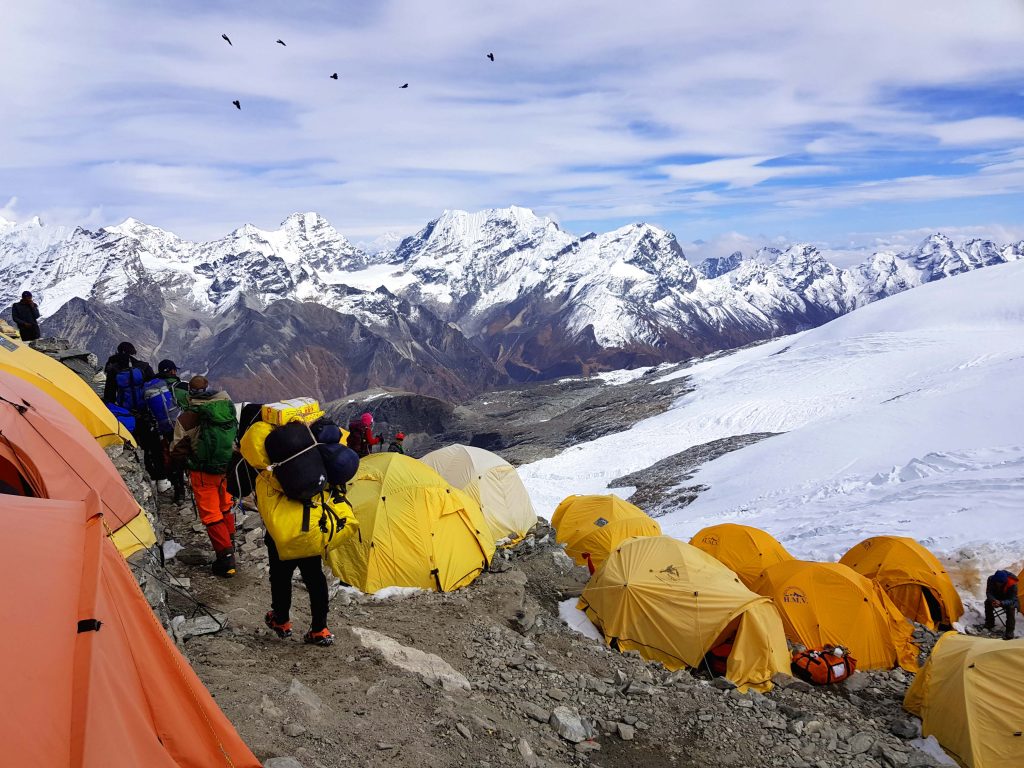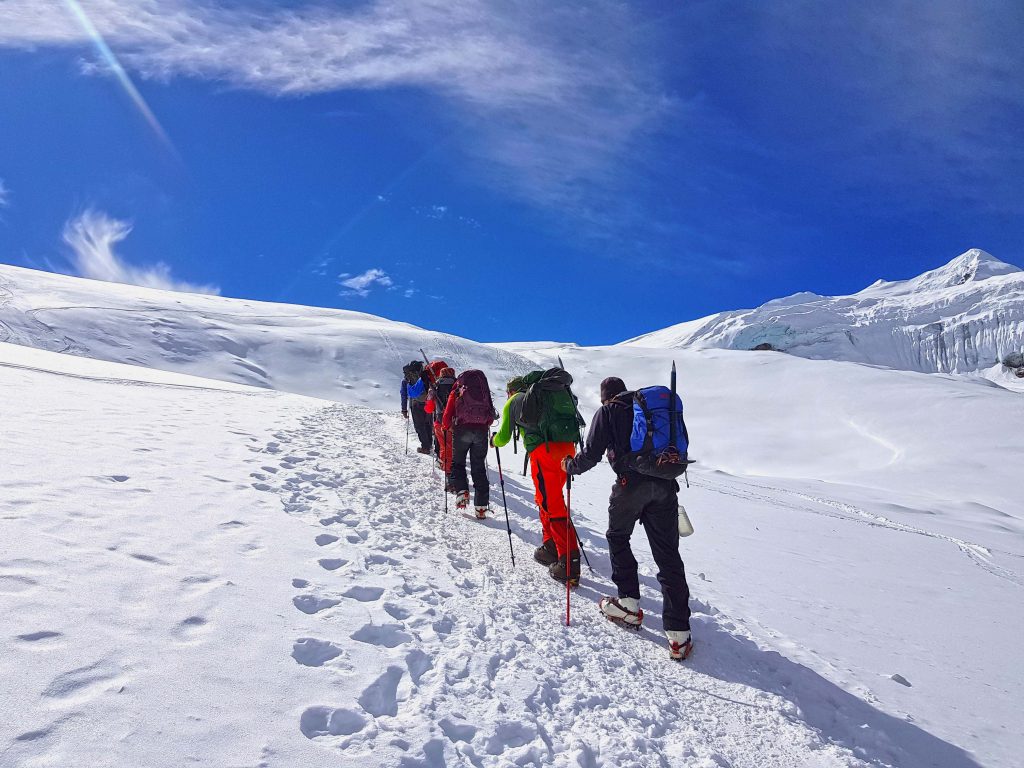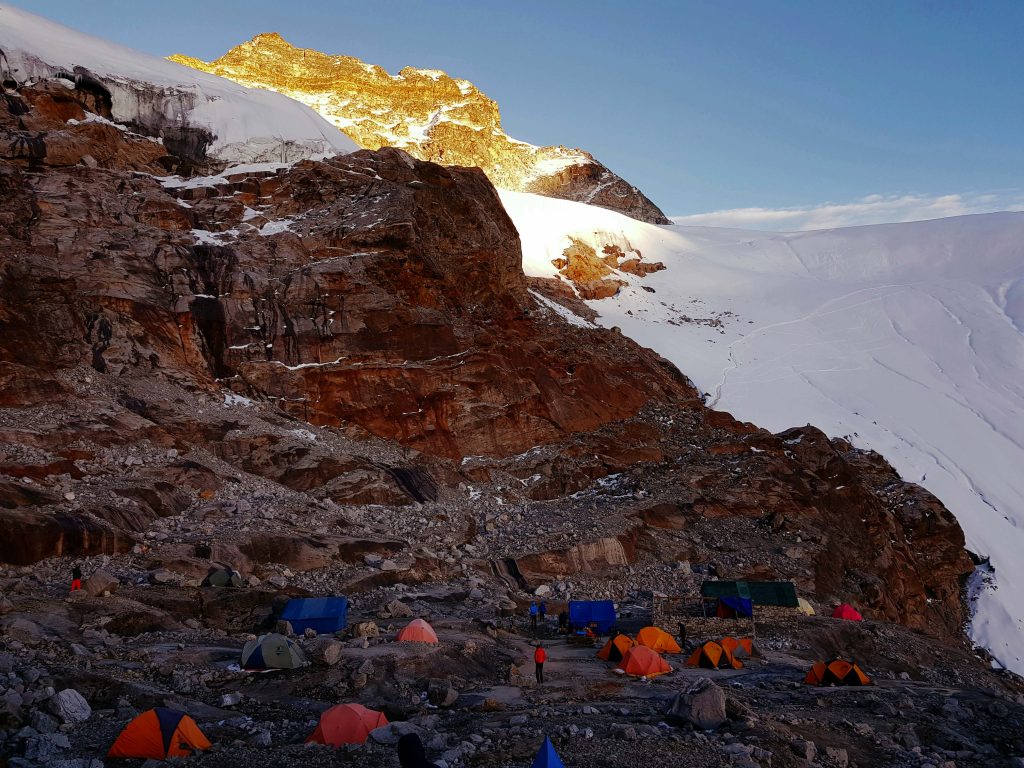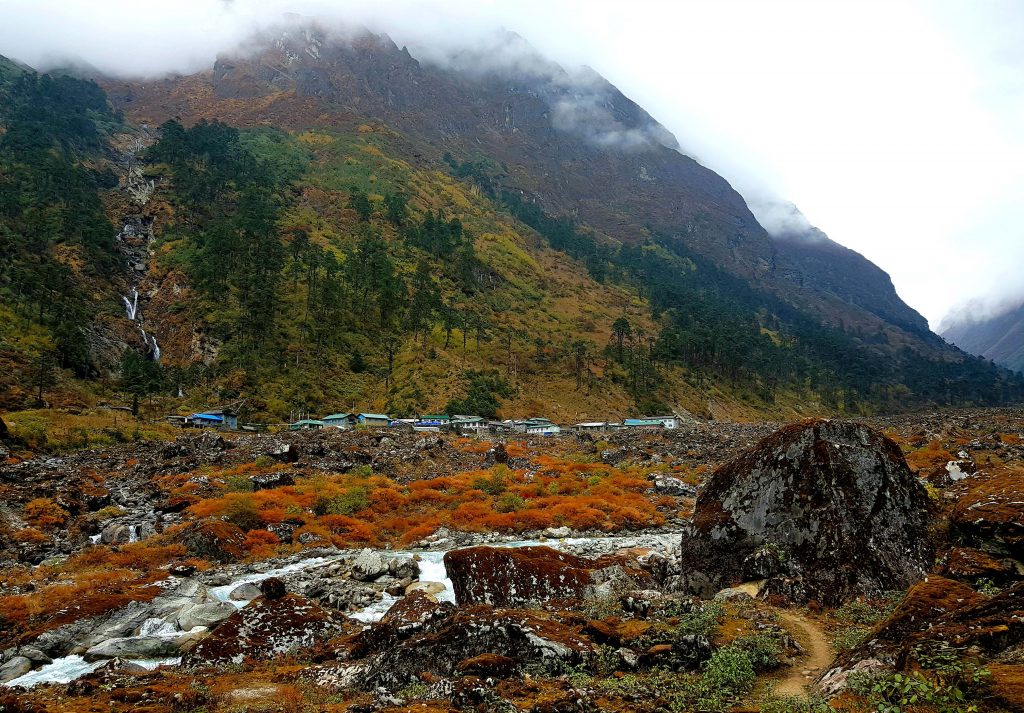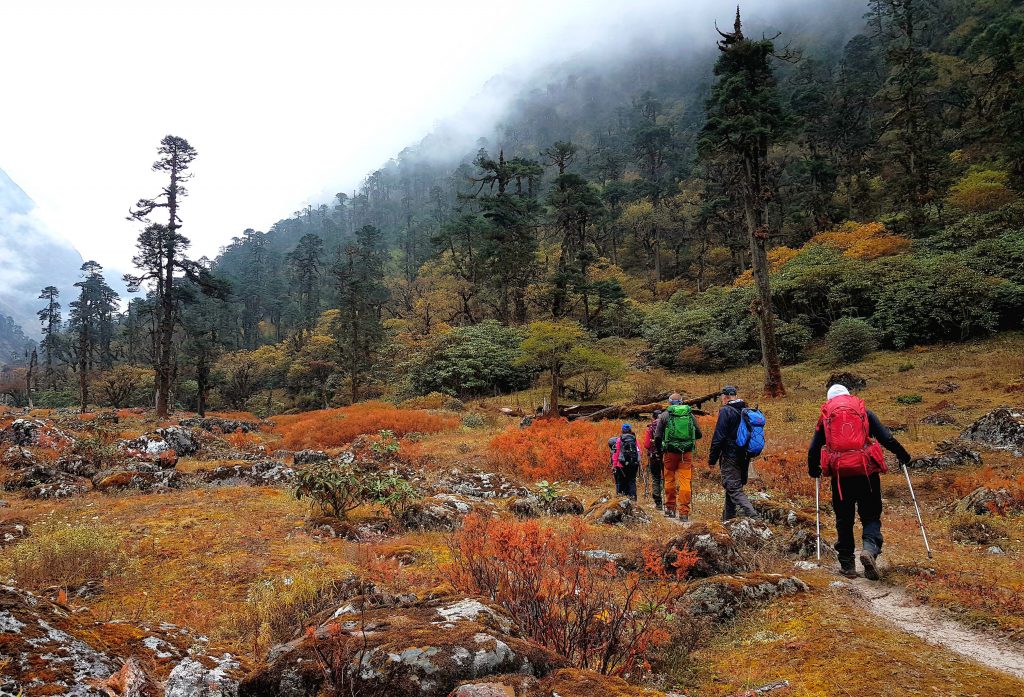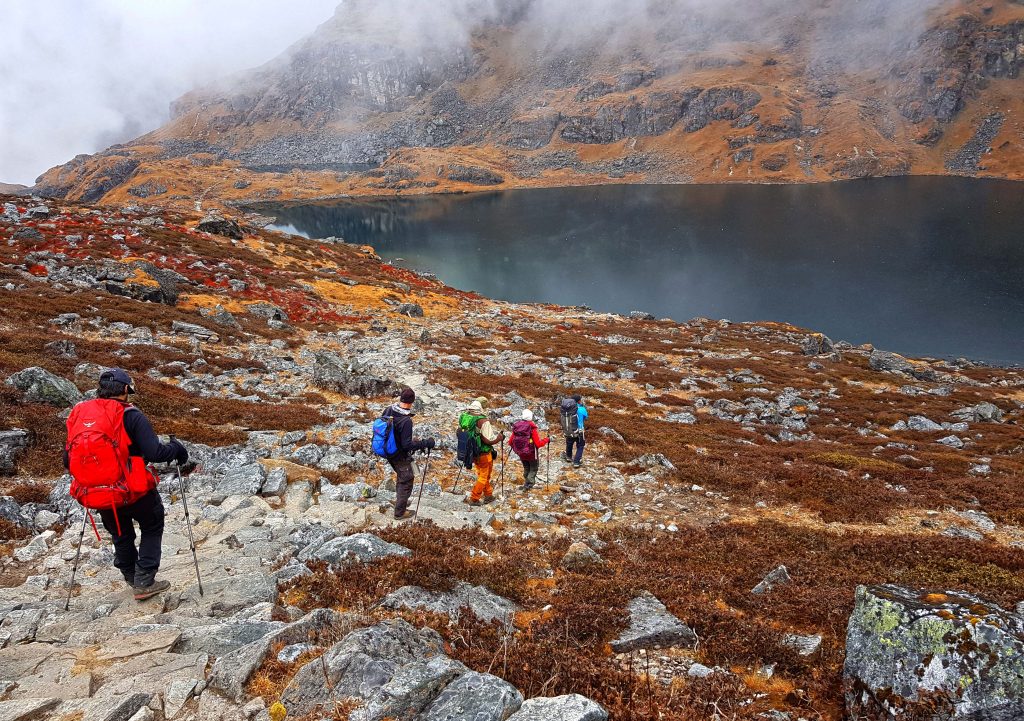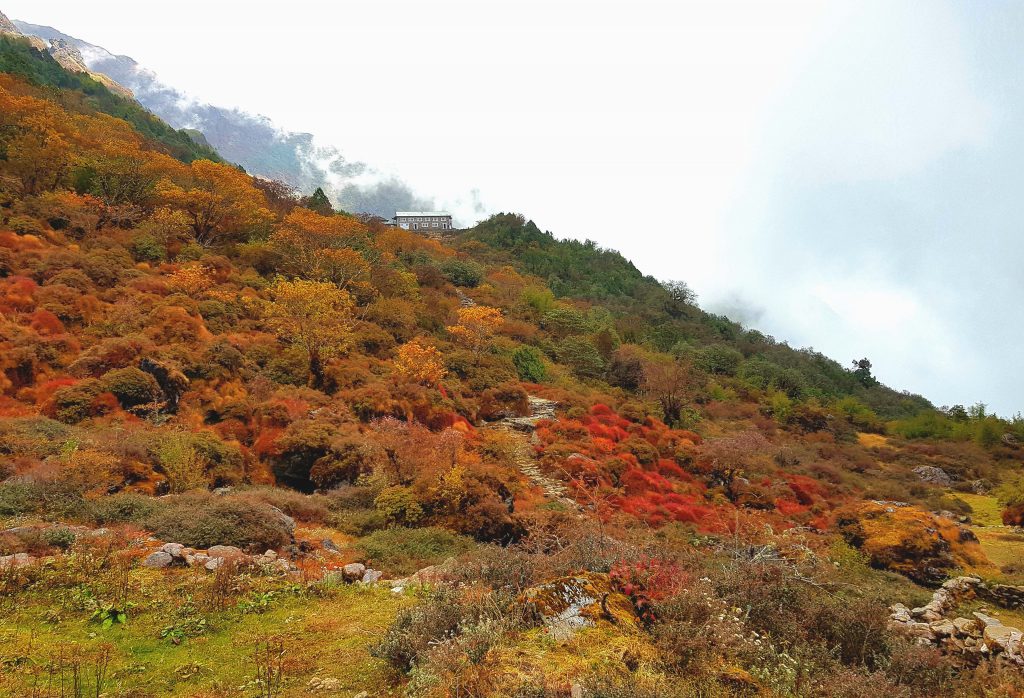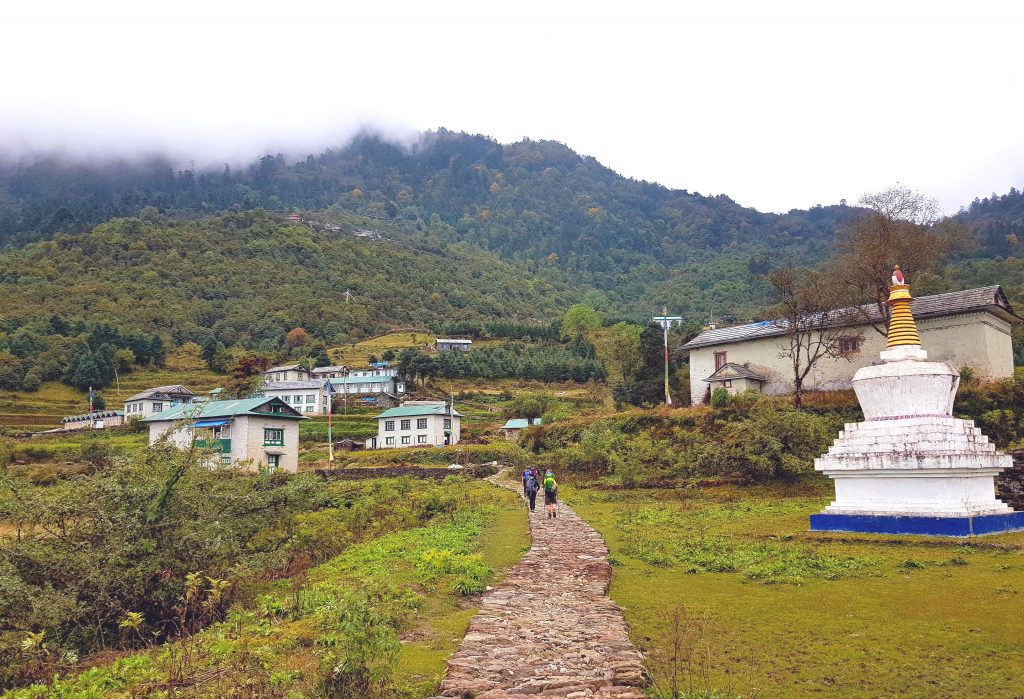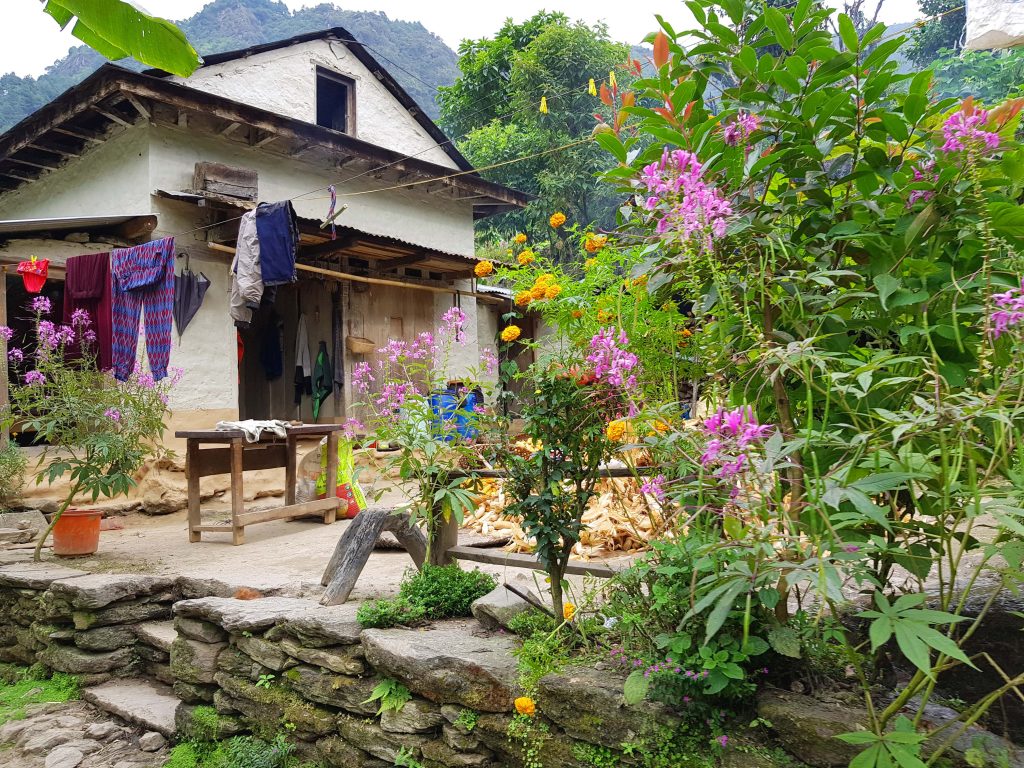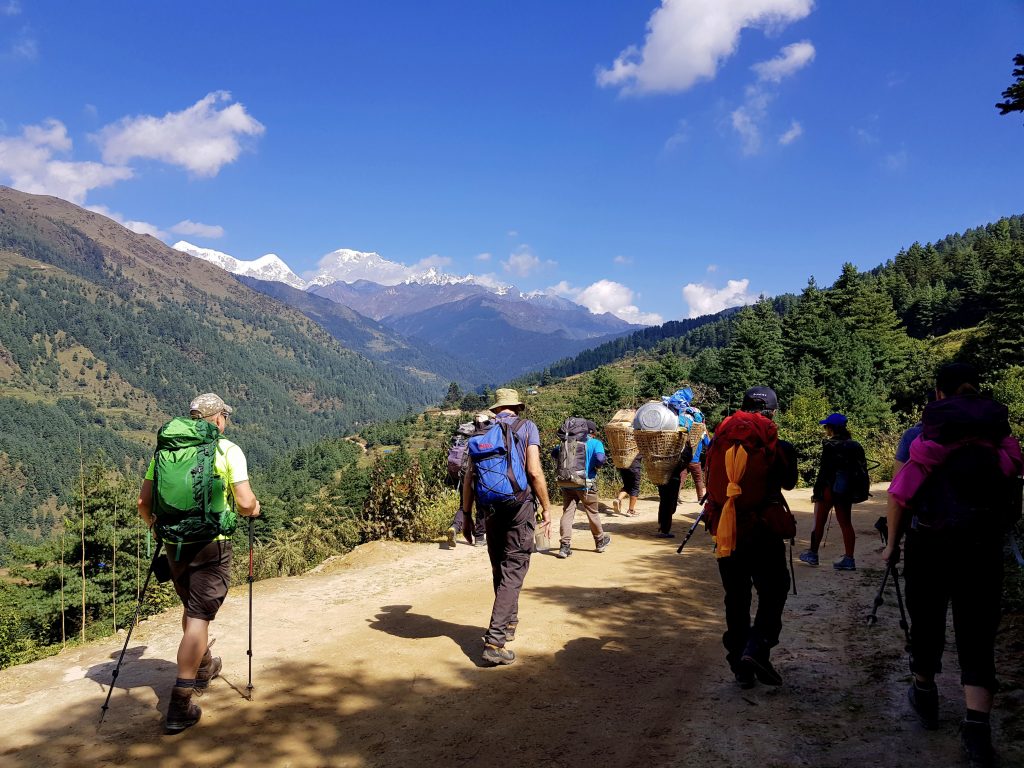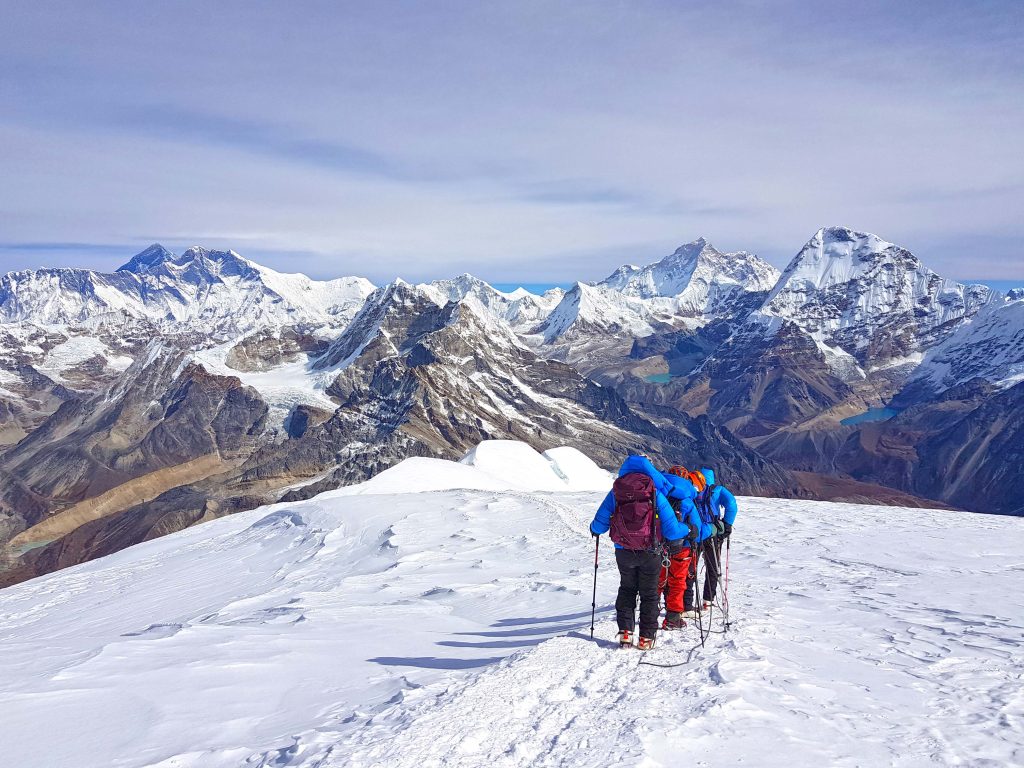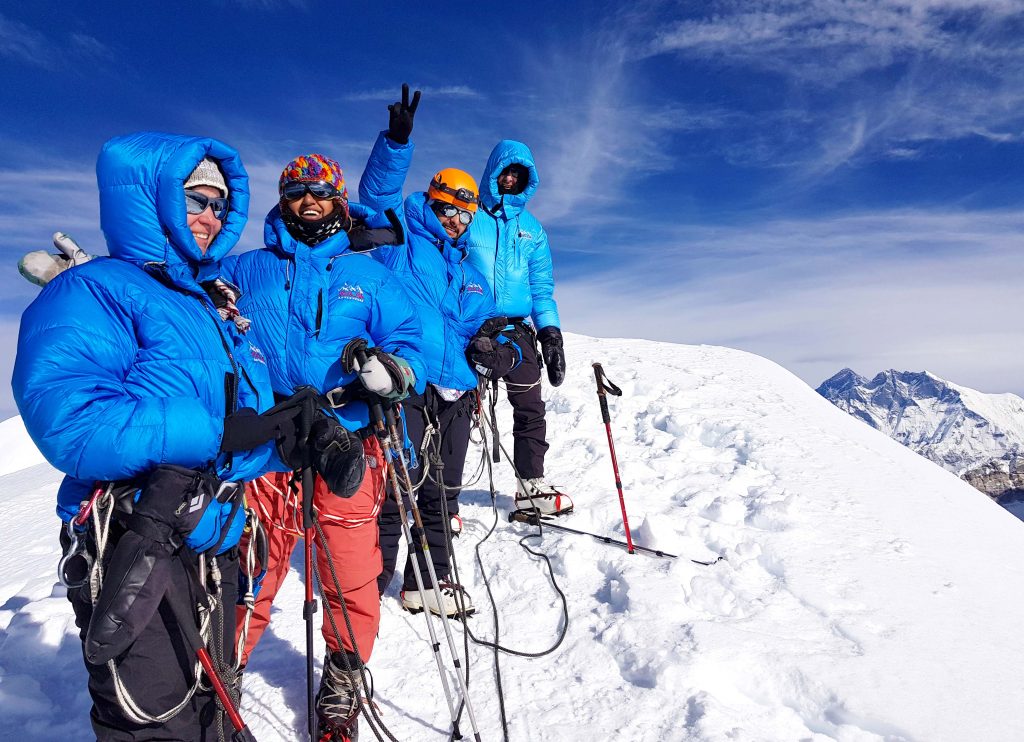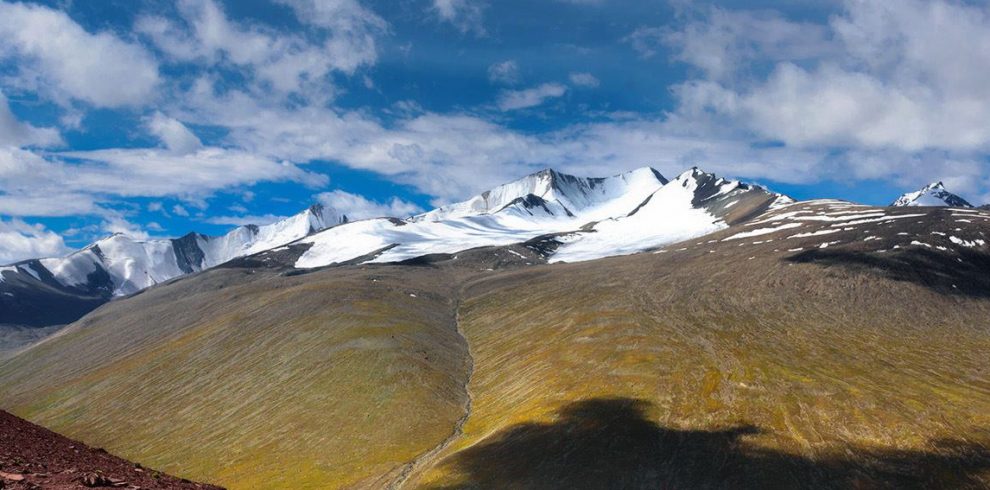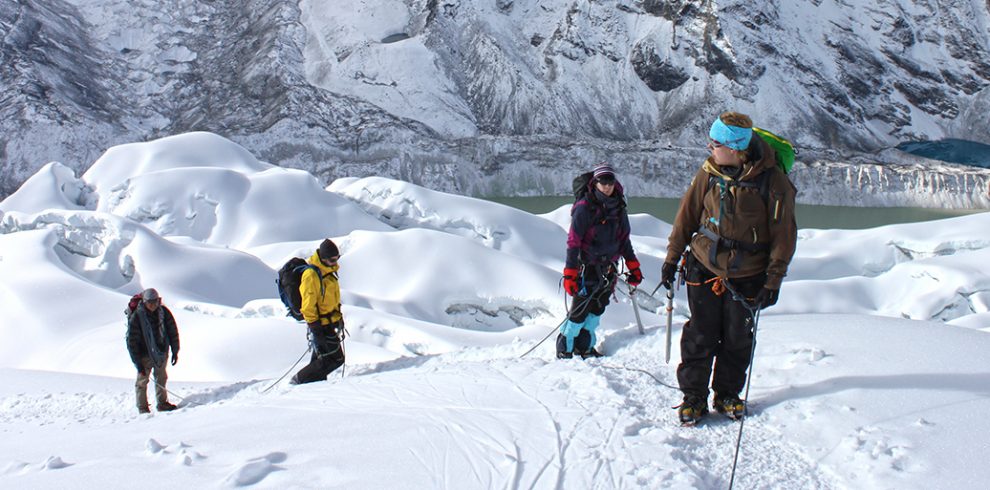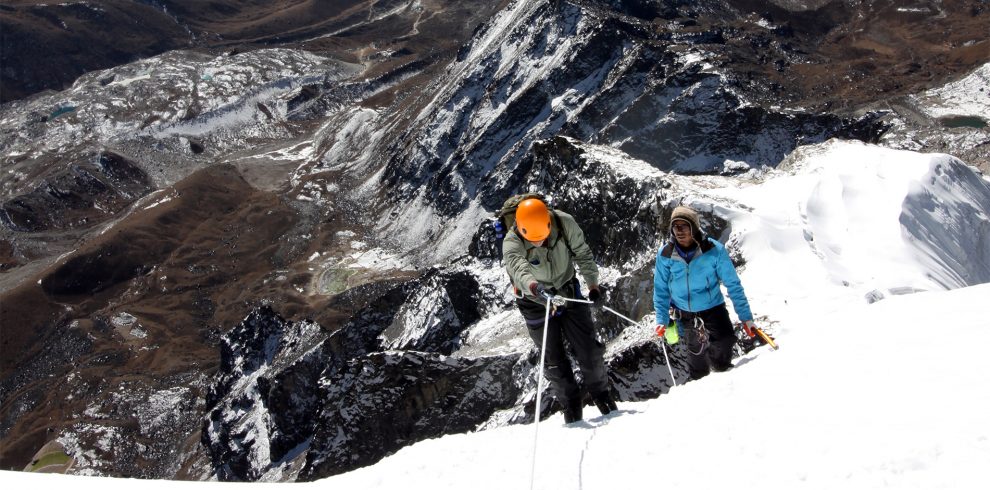Mera Peak at 6,476m is situated to the south of Mt. Everest. It was first climbed on May 20, 1953 by Col. Jimmy Roberts and Sen Tenzing.
It is considered as one of the best trekking peaks in Nepal. Firstly, because it requires only basic mountaineering skills to summit this height, secondly, the panorama from the summit is simply unmatched, and thirdly, the approach to this mountain is through the beautiful Hinku valley which is much less crowded than the Khumbu valley, providing a fantastic trek which will be as memorable as the climb itself.
From the summit of Mera Peak one can see five of the six highest mountains in the world: Mt. Everest (8848m), Cho Oyu (8201m), Lhotse (8516m), Makalu (8463m) and Kanchenjunga (8586m).
Overview
Unlike many tour operators that take their clients straight over the 4610m Zatra La, which is a tough and dangerous way to start the trek due to the quick gain of altitude, we have a much gentle approach to the mountain. Our trek begins from Phaplu, passing by picturesque farming villages of Nunthala and Kharikhola towards Pangom, and then enters the Hinku valley crossing several passes along the way, getting ourselves well acclimatized before reaching the Base Camp. We will set up our Base Camp at the Mera la (5200 m). An Advanced Base Camp will be set up at 5760 m from where we will attempt the summit.
What makes this expedition special
- One of the easiest 6000 m + mountains. Technical skills or previous climbing experience not required but fitness is mandatory.
- Probably the best panorama form the summit than any other trekking peaks in Nepal
- Views of five of the six highest mountains in the world: Mt. Everest (8848m), Cho Oyu (8201m), Lhotse (8516m), Makalu (8463m) and Kanchenjunga (8586m).
- Beautiful trek through alpine forests and rhododendron valleys staying at remote villages
- Considerably less crowded trails compared to Khumbu trail.
Itinerary
Once you reach KTM airport and finish with the immigration and custom formalities be prepared to confront the confusion outside the airport which is common in most of the south Asian countries. As you walk out of the Exit door into the passenger pick up area you will see hundreds of people with different sign boards in their hands, taxi drivers looking for fares, hotel touts looking for customers and porters trying to help with the luggage for tips. Please remain calm and do not walk out of the restricted area into the crowd straight away. Remain there and try to find the Hi On Life’s sign board. Once you spot it, walk straight to the signboard and identify yourself. From here we will take care of you.
When you arrive to your hotel you will be briefed about your activities and “do’s and don’ts” while your stay in Kathmandu. We will also collect some documents from you. Please have the following things handy when arriving.
Travel/ Medical Insurance (photo copy)
3 passport size photos
Photocopy of your passport.
In the evening we will go for a traditional Nepali dinner at Kathmandu’s finest Nepali restaurant to end the day.
Fly to Phaplu: 30 mins
Trek: 2 hours
Elevation of Phaplu: 2415 m
Elevation of Takshindu: 2900m
An early morning scenic mountain flight from Kathmandu to Phaplu. Upon arrival to Phaplu, we will take a jeep to Ringmo which will take about an hour. Here we will meet our crew and then trek to Takshindu. Takshindu has the largest monastery school in Nepal.
Overnight Lodge
Trekking: 8 hours
Elevation of Kharikhola: 2200 m
After breakfast we hit the trail with a steady and steep descent of about 600m Nunthala. Nunthala is a small town with many lodges, a fuel depot and a cluster of houses. After a tea break at Nunthala we continue descending about 500m again to Juving Khola, where we cross a suspension bridge to get across the Dudh Kosi (Literal translation= milk river, because of its white color). After crossing the river, we will climb for 40 mins to reach the village of Juving where we will take our lunch break. Juving is a beautiful village with orange, banana and guava plantation that gives a feeling of sub tropical farmland. After lunch, a steady ascent of about 500 m which takes about two hours will bring us to Kharikhola. Kharikhola is one of the largest settlement of the entire Solu Khumbu district. This village has a high school and is an important education town for the entire district. This village had a multi cultural population consisting of ethnic groups of Magars, Rais, Newars, Tamangs and Sherpas.
Overnight Lodge
Trekking: 4 hours
Elevation: 2900 m
The trail begins with a steady climb heading straight out of the village. The trek is mostly through forest and it takes roughly 4 hours before we reach Pangom at lunch time. Pangom is an extremely picturesque Sherpa village. It is a fairly big village with lodges and local houses.
After lunch you are free to explore the village on your own.
Overnight Lodge.
Trekking: 6 to 7 hours
Elevation: 2720 m
The trail climbs past the village passing “mani walls”and soon we walk through rhododendron forest and bamboo for about an hour up to Pangom La where we get our first view of Mera Peak. After the pass, we descend for about an hour to Sibuje Village where there are a few lodges. From here the trail descends steeply for about 2 hours on a loose trail to a suspension bridge which crosses the Hinku Khola. We stop here for lunch. After lunch, we climb steadily through dense forest for about 2 to 2 ½ hours to Nazing Dingma. Nazing Dingma is a small hamlet with half a dozen small lodges and cow and yak pastures.
Overnight Lodge
Trekking: 4 hours
Elevation: 3600 m
We begin with a steep climb on stone staircase through bamboo and rhododendron forest for about an hour to reach Surke la. This pass leads towards east to the villages of Bung and Tumlingtar where the Makalu base camp trail intersects. There is a lodge at the top of this pass and we will stop here for a tea break. After tea, we leave this trail and follow a narrow off the beaten track towards north. The trail passes through Rhododendron and bamboo forest and soon we come out in the open where there are a few timber depot and sheep pastures. The trail continues north of this open pasture and climbs a ridge with bamboo forest and after a couple of hours we reach Cholem Kharka.
Overnight Lodge
Trekking: 4 to 5 hours
Elevation: 4200 m
The trail climbs steeply to a small pass which takes about a couple of hours. There are fantastic views of the Hinku valley and the peaks of Kusum Kanguru and Khyasar Khang. After taking a short break we continue to climb; now an even steeper switchback made of stone staircase until we reach the highest pass. It takes about an hour and a half to reach the top of this pass. After the pass it is about 30 mins descend to Panch Pokhari, which are a cluster of 5 lakes and hence the name. We usually take packed lunch this day and this place with the views of the lake is an excellent place to stop for lunch. After this break it is an easy 40 mins walk to our camp.
Overnight Lodge
Trekking: 6 to 7 hours
Elevation: 3600 m
The trail climbs steeply for about 45 mins to a pass. From here there are great views of the valley ahead. The trail is undulating and follows the side of the exposed mountain for about 2hours until we start to descend gently down to the tree line. Here we stop for lunch. After lunch we descend steeply into a rhododendron and birch forest and after about a couple of hours we reach the bank of the Hinku Khola. From here we ascend gradually following the river upstream for about an hour to reach Khote. Kothe is a small and beautiful village that gives an impression of a village from a wild-west Hollywood movie. There are several lodges and shops selling trekking clothes and local bars with “carrom board” which is a kind of table snooker with small discs instead of balls. Here we also have the check post of Makalu Barun national park. We will need to entry your permits and pay national park fees.
Overnight Lodge
After having trekked for 6 days through rough terrain and steep ascents and descents we deserve a rest day here at Kothe. This day is mainly to let you relax your tired muscles and build up energy and get prepared physically and mentally for the days ahead. You can also utilize this day for showers, washing clothes etc.
Overnight Lodge
Trekking: 4 hours
Elevation: 4400 m
Today is an easy walk with not much climbs, but watch out for loose falling rocks along the bank of the river. We will follow the river upstream along the erosion caused by the river system. It is a gentle and gradual ascent along the bank of the river for about 4 hours before we reach Thangna. Thangna is situated at an even flat area with breath magnificent views of the mountain peaks surrounding it. The peaks of Kyashar Kang lies towards the North and Kusum Kang Guru and Kangtega glacier towards North West. There are a few lodges here. We will stop here for the night.
Overnight Lodge
Trekking: 4 hours
Elevation: 5000 m
Today is again an easy walk following the Hinku Khola. There are no steep ascends and descends and most of the time we are gradually climbing without even noticing the gain of elevation. We can see the Mera La right in front of us. Just about an hour before reaching Kahre, we will start to climb steeply until we reach Khare by lunch time. Upon arrival to Khare, we will have lunch and settle to our rooms. In the afternoon we will take a gentle exploration of the area.
Overnight Lodge
Today we will have some ice climbing training and safety instruction. For those who have never walked with big climbing boots and crampons, it is an excellent opportunity to practice that. After lunch we will go through your climbing gears and make necessary preparations for the climb.
Overnight Lodge
Trekking: 3 to 4 hours
Elevation: 5400 m
Right from the lodge we will start to climb gently and steadily along a ridge. There are amazing views of the mountains surrounding us and after an hour and a half climbing along this gentle ridge, we reach the bottom of the Mera glacier. There are a few sections here where we have to clip on to fix ropes as we climb the steep sections of the glacier. Once we climb this section, we are above the steep section and we walk across the Mera glacier. There are a few section where we will require to walk on crampons. It takes about 3 to 4 hours to reach Mera La, which is a beautiful snow covered pass between the Hinku basin and the Honku basin that leads to Mt. Baruntse. We will camp right on top of this pass.
Overnight Tented Camp
Trekking: 3 hours
Elevation: 5780 m
Today will be an easy and relaxing morning since it is only about 2 to 2 ½ hours climb to High Camp from our camp. After an amazing morning having breakfast at the snow covered pass we will continue to climb to High Camp. It is a not so steep climb along the snow field to High Camp. We will reach High camp at lunch time. After lunch we settle in to our tents and make final preparations for your big day the next day. We will make sure everything from climbing gears, clothes and accessories are ready and you may take some rest since it will be an early morning the next day.
Overnight Tented Camp
Trekking: 10 to 12 hours
Elevation: 6476 m
We will wake up around 2 AM. Breakfast will be served right away in your tent, which will be some museli/ porridge, biscuits and nuts and some tea. We recommend you to carry your favorite snacks for the climb. At around 3 AM we start the climb and so it begins. The first part of the climb is a gentle ascent of about 20 to 25 degrees with switch backs along the face leading to the summit. We will climb on main rope attached to each member in groups of 4 to 5. We reach the bottom of the final ice serac, which leads to the summit, after a steady 5 to 6 hours climb. From the bottom of this serac we will fix rope and you will need to climb the fixed ropes using jumars for about 20 meters. Soon we are at the summit!
The views are unfathomable with views of 5 of the world’s highest mountains viz. Mt. Everest, Mt. Kanchendzonga, Mt. Lhotse, Mt. Makalu and Mt. Cho Oyu dominating the Northern Skyline. Towards the South, you can see the cascading hills receding towards the Great plains of India.
After a victorious moment spent at the summit, we will start to descend down. It is a good 11 to 12 hours day from High Camp to summit and back to Khare.
Overnight Lodge
Trekking: 5 hours
Elevation: 3600 m
We will retrace our way back to Kothe down the Hinku valley. We arrive Kothe early, so you can use this opportunity to take shower.
Overnight Lodge
Helicopter: 15 mins
Morning Helicopter ride to Phaplu which takes about 15 mins. If we are able to take an early morning flight to Phaplu, then we will take a jeep to Thade so that the next day drive is shorter. Otherwise, we will explore Phaplu and take a jeep the next day to Kathmandu.
Overnight Lodge
Drive duration: 270 Kms, 9 Hours
Overnight Hotel
We have allowed this extra day as a buffer day in case of flight cancellation from Lukla back to Kathmandu. If we have not used this day for any delays contributed to flight cancellations, then we can use this day for sightseeing around Kathmandu valley.
Places you will visit:
Boudhanath Stupa: It is the largest stupa in Nepal and the holiest Tibetan Buddhist temple outside Tibet.
Kathmandu Durbar Square: Commonly called Basantapur Darbar is one of three Durbar (royal palace) Squares in the Kathmandu Valley in Nepal, all of which are UNESCO World Heritage Sites.
Durbar Square was surrounded with spectacular architecture that showed the skills of the Newar artists and craftsmen over several centuries, but several buildings in the Square collapsed due to a major earthquake on 25 April 2015.
We will drive you to Tribhuwan International airport about 3 ½ hours before your departure time.
Cost Includes
- All airport transfers and internal transportation in private vehicle
- Welcome dinner.
- 3 nights at 3 star hotel accommodation on bed and breakfast plan
- Half day guided city tour with lunch.
- Kathmandu Phaplu flight
- English speaking experienced expedition guide
- Climbing Sherpa 1:3 (Sherpa to member ratio)
- Cook and kitchen helper
- Porters
- Use of a personal trek pack, consisting of: Duffle bag, down jacket and sleeping bag
- with an inner-liner.
- Use of climbing equipment: ropes, carabineers, pitons, jumars, ice axe,
- harness, and descender.
- Emergency use of Pressure bag (Gamow bag) and oxygen cylinders.
- Accommodation at lodges and camping where required with all meals during the entire expedition
- Camping and kitchen facilities.
- All meals (Breakfast, lunch and dinner) during the expedition.
- Afternoon tea/coffee service on arrival at camp.
- Boiled and treated water as needed.
- Helicopter from Kothe to Phaplu
- Private jeep from Phaplu to Kathmandu
- All climbing permits and National Park fees.
- Staff insurance, tourist service fee and all taxes applicable as per state law.
Cost Excludes
- Personal accident and rescue insurance. You must provide your own rescue insurance
- Mineral water, beer, soft drinks and extra tea/coffee outside of normal meal times.
- Private room accommodation in Kathmandu unless a single supplement is paid.
- Optional tips to guides and porters.
- International airport departure taxes.
- Visa costs.
- Helicopter evacuation in the unlikely situation, although we do arrange for it and make
- the necessary documents so that you can claim from your insurance.
Map
Himalayan Mountaineering
Ever since the Himalaya in Nepal has been opened for climbing, it has attracted thousands of mountaineers. Thousands of people have challenged their minds and bodies to conquer these magnificent mountains.
Nepal Himalaya has numerous of mountains which are 7 000 m and higher, which require extensive technical experience and a lot of money to climb. Apart from these technical expedition peaks, there was created in 1978, under the control of the Nepal Mountaineering Association (NMA), a list of mountains, between 5 587 m to 6 654 m, called “Trekking Peaks”. Unlike the technical expedition peaks, which are a complicated and an expensive affair, these “trekking peaks” can be climbed without financial and administrative problems. There are 1 310 identified peaks which are above 6 000 m, one fourth are officially opened for mountaineering.
Mera Peak
Mera Peak is a beautiful mountain located in the Hinku basin, south of Mt. Everest. We approach this mountain via Pangom, which is south of Lukla. The trek in itself is extremely beautiful with views of scores of snow covered peaks, glaciers, alluring waterfalls and alpine forests with birch, pines and rhododendrons. We also stay at a few remote and non touristic villages where we can experience the rich culture of the Sherpa people.
Mera Peak offers an opportunity to climb such high altitude without the experience of previous climbing. It’s a good mountain for trekkers who would like a straightforward introduction to mountaineering. Most part of the ascent involves a walk up a glacier requiring basic ice axe and crampon skills. There are plenty of opportunities to gain proficiency in these during our ice climbing training at Base Camp. Although the mountain needs nothing more than glacial walk at inclination not increasing 30 degrees, the final summit dome involves a 30 metre ascent of a 60° inclination using fixed rope and jumar, depending on snow conditions.
Grading: This expedition is graded II B. Please read our Grading system.
Please note: Any ascent of a Himalayan peak must be taken seriously. The Group leader will take all factors concerning group fitness and acclimatization, weather and snow condition into consideration when making a decision. While recognizing that this ascent is important to the group, first priority will always be safety. The decision on whether or not you will be able to attempt Mera Peak rest with the Group Leader. His/ her decision is final and must be accepted.
A Day on Your Trek
Although each day is different, considering the weather, general pace of the group and length of the days walk, in general your day begins with a wake up tea at around 6 to 6:30 in the morning. You will then be provided with a bowl of warm water for washing. Then you will need to pack your duffel bag and your daypack and come to the lodge’s diner for breakfast.
After breakfast we will hit the trail and usually walk for about 3 to 4 hours before we stop for lunch. We will give you about an hour and a half rest during lunch, which will also give enough time for the staff to have their lunch and pack. Usually after 3 to 4 hours of walking we finish the days walk by 4 PM. Tea/ Coffee and snacks will be served on arrival to the lodge. Your group Leader will often organize side trips in the afternoon. Your dinner will be served around 7 PM.
Please note: This is a camping trek, however, wherever we find a decent lodge we will arrange for rooms for you to sleep. All meals during the entire expedition will be cooked and served in the dining tent or dining room of lodges by our staff.
High Altitude
On this trek you will be going up to 6476m, so it is very important to understand the affects of altitude. The greatest provocation is going too high too fast. Hi On Life’s itinerary has been carefully designed to minimize the effects of altitude. We ascend slowly and surely allowing enough time for safe acclimatization.
Headaches and breathlessness are common at altitude which in itself is nothing to worry about. In rare cases, this may worsen to Acute Mountain sickness (AMS), so a close watch is kept on all trekkers by the group leader who is trained to recognize the symptoms of AMS which are severe headaches, nausea, lethargy, loss of appetite serious breathlessness even at rest. If any trekkers show such signs they will be descended to relatively lower and safer altitude. The Group Leader’s decision on evacuating such person to a safe altitude is final. Do not medicate yourself without first informing your group leader. Going to altitude slowly with adequate rest and adequate intake of fluid (3 to 4 litres per day), you will most likely have no problems apart from breathlessness on hills which is completely normal as the percentage of Oxygen in the air is relatively lower to that at sea level. The most important thing is not to worry about altitude because our team is there to take care of you.
Staff
Group leader: your most important member of your staff. Our Group leaders are highly trained in all aspects of the trek, conservation, first aid specializing on altitude sickness, emergency procedures and have extensive knowledge of the natural history of the area.
Sirdar: His job is to manage and organize staff duties. He is responsible for the actual operation of the trek.
Sherpas: Their job is to lead your way and distribute equal loads to the porters.
Cook: Responsible for your food. Hygiene of a high standard is taken into consideration in preparing the food.
Porters: They are responsible to transport your duffle bags and their job finishes once they reach the designated lodge. Our porters are provided with Gore-Tex suits, trekking boots, gloves, hats, socks, snow gaiters and snow goggles. Most importantly, we regulate them on a 25 Kg carrying which no other company does. Our clients can therefore feel comfortable knowing that our porters are working in a good humane condition. During the trek you can see porters carrying 60-70 kg and sometimes even more than 100 kg!!)
Weather:
Oct/Nov and March/April
On the trek at lower altitude (2500m to 3500m) during daytime the Max temp can be around 10C to 15C and the Min temp can be 3C to 7C
At higher altitude (4000m to 5000m) the daytime Max temp can be between 2C to 7C and Min temp can be between -10C to -5C
On your summit day: You can expect between -15C to -18C + wind chill factor depending on the wind speed
Dec to end of Feb
On the trek at lower altitude (2500m to 3500m) during daytime the Max temp can be around 0C to 5C and the Min temp can be – 5C to 2C
At higher altitude (4900m to 5000m) the daytime Max temp can be between -5C to 0C and Min temp can be between -10 C to -20C
On your summit day: You can expect between -15C to -20C + wind chill factor depending on the wind speed
Please note that this is just general information and it could vary.
Recommendations for things you should bring:
Clothing:
Head:
- Warm hat wool or synthetic that covers your ears
- Balaclava
- Sunhat
- Glacier sunglasses with side shields, 1 pair ski goggles (optional)
- Headlamp with extra batteries
- Buff or head scarf, also useful for dusty conditions
- 2 polypropylene or wool mix t-shirts
- 2 polypropylene or wool mix long sleeve t-shirts
- 2 long sleeve thermal underwear shirts, lightweight preferably woolen
- 1 polar fleece pullovers medium weight or 1 heavy wool thermal underwear
- 1 polar fleece jacket, OR Primaloft/ Down light weight jacket
- Gore-Tex jacket with hood, waterproof and breathable
- For high altitude use, 1 very warm goose-down jacket with hood (we provide this)
- 1 pair walking shorts
- 1 to 2 pair walking trousers for trekking
- 2 pair lightweight thermal bottoms
- 1 pair medium or expedition weight thermal bottoms OR polar fleece trouser
- 1 pair Primaloft OR light weight down trouser for evenings at Base Camp and Advance Base Camp
- 1 pair Gore-Tex trousers, Waterproof/breathable with side zips
Feet:
- 1 pair climbing boot preferably for 6000m+ (you can also hire plastic boots in Kathmandu)
- 1 pair treking /walking boots with good ankle support
- 1 pair trainers, running shoes and/or sandals for Kathmandu and in camp;
- 1 pair down booties (optional)
- 2 pair med-heavy preferably wool socks
- 2 to 3 pair of liner socks. Polypropylene or wool
- 2 to 3 pair lightweight trekking socks, poly or wool
Sleeping:
We provide:
- 1 down sleeping bag (rated to – 20 Centigrade or -0 F )
- 1 polar fleece liner
- Exped Down 7W mattres and foam kari-mats.
Rucksack and Travel Bags:
- 1 medium rucksack (40-50 litres)
- We provide you 1 big duffle bags.
- Small padlocks for duffel kit bags.
Assesories:
- 1 small roll of repair tape, 1 sewing repair kit
- 1 cigarrette lighter
- 1 compass or GPS (optional)
- Camera
- Nylon stuff sacks for food and gear storage, large Ziplocs are useful also
- 3 Water bottles (1 litre)
- 1 small folding knife
- Books, playing cards, ipod/mp3 player, games, small musical intruments
- Adequate amount of batteries, etc.
Healthy and trouble free holiday
There are no compulsory vaccinations required for entering Nepal. However please consult a doctor for vaccination against Typhoid, Meningitis, polio, and hepatitis. If you have special dietary requirements or allergies, please through your agent, give us a list of what you can and can’t eat so that we can provide proper food for you.
If you are undergoing a course of prescription medicine, please ensure that you have sufficient supplies for the entire holiday. Some types of drugs including antimalarials have side effects at high altitude; therefore please consult your doctors regarding these drugs. The places you trek are mosquito free and there has been no report on malaria in Kathmandu for the past couple of decades.
Insure yourself
We highly recommend you to take a comprehensive Personal Travel Insurance before leaving home. This should cover for your loss of baggage, airline delays, sickness and accidents. And it should also cover you for Emergency Helicopter Evacuation.
Money Matters
The ideal currency to bring with you is USD.
In Kathmandu: Each meal will cost around 4 to 6 USD. Plus 10 to 20 USD for your taxis if you wish to go around the city.
On trek: You will need around 6 to 10 USD per day. This money is for your hot showers, chocolates, soft drinks and beers etc and also for small donations in the monasteries.
Tipping
Although tipping is entirely optional and personal matter the following is recommended as a guideline
In Kathmandu: for bellboys, waiters and porters 30 to 50 Nepali Rupees
On the trek: At the end of the trek it is a customary to tip the field staff.
- For Staff: 100-150 USD depending on group size. The group leader will collect the tip and then split it between the staff and put it in envelops so that the trekkers can give it to the staff during the “Farwell Ceremonies”. Your Group Leader is not included in this tip.
- For Group Leader: 30 to 50 USD per person
Some Do’s and Don’ts
Nepalese people treat visitors as special guests. Although they will never rebuke you publicly for unknowingly offending them, we must consider their culture.
While in Nepal please observe the following:
- Full or partial nudity is not accepted
- Over display of affection between men and women, especially in temples and monasteries are discouraged
- Please remove your shoes before entering monasteries and temples
- Never point the soles of your feet at a person or shrine
- Many Hindu temples are closed to non-Hindus. Please ask before entering
- Locals walk around the Mani walls and Stupas in a clockwise direction as a respect and they expect you to do the same although it is not compulsory
“TODAY IS YOUR DAY! YOUR MOUNTAIN IS WAITING, SO… GET ON YOUR WAY!”
DR. SEUSS


